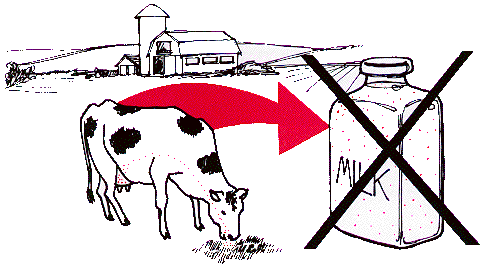Pesticide Residue, Tolerance,and Registration
 Pesticide Residue, Tolerance,and Registration
Pesticide Residue, Tolerance,and Registration
The use of pesticides is strictly controlled in the United States. Every
chemical which has possible use as a pesticide is closely tested and reviewed
before it is marketed. The laws controlling the use of pesticides on food or
feed crops are more strict. The amount of pesticide remaining on the crop at
harvest is carefully regulated.

Goals of This Chapter:
- Distinguish between deposits and residues.
- Understand both the positive and negative features of long- lasting residues.
- Explain a tolerance and the criterion involved in setting a tolerance.
- Determine the importance of "Days to Slaughter" and
- "Days to Harvest."
- Learn what information is important in registering a pesticide.
Residues
The pesticide which is on the leaves, skin, or other surface right after
application is the deposit. Sometimes the deposit can be easily seen, as
with many dusts or wettable powders. At other times it cannot be seen with the
naked eye. If the pesticide deposit remains on the surface for a period of time,
it is called a residue. Some pesticides leave little or no residue. Heat, light,
moisture, soil organisms, and other chemical reactions in the environment
quickly break them down. Other pesticides are not quickly broken down. They
leave a residue on the crop or in the environment for weeks, months, or years.
Depending on how and where it is used, each pesticide will vary in how long a
residue remains on the crop or surface. Therefore, information on residues is
required on each crop the pesticide is applied to. Unfortunately, a pesticide
may drift over from a nearby field and leave a residue on a crop or surface.
 Would you like to try a
study question?
Would you like to try a
study question?
A long-lasting residue may be desirable because the pesticide is effective for a
longer period of time. It need not be applied as often and thus may be cheaper
to use. However, long-lasting residues are not always desirable. The chemicals
may remain on food or feed and be hazardous to those eating them. The residues
may remain in the soil to interfere with crops that are planted at a later date.
Or they may remain on the surface and injure workers or others who reenter the
treated area. Clearly it is important to know what residue, if any, remains
after a period of time. Food, in fact, may have no residue because it may never
have been treated, or it was treated at less than the maximum dose and the
residues may have degraded.
 Would you like to try a
study question?
Would you like to try a
study question?
 Would you like to try a study question?
Would you like to try a study question?
 Would you like to try a
study question?
Would you like to try a
study question?
Tolerances
Many times residues remain on food or feed crops at harvest time. Since these
crops are to be eaten, safe amounts of residues must be established. The maximum
amount of residue which may remain on a harvested crop is called a tolerance.
Federal law requires that a tolerance be set for every
food or feed use of each pesticide before it is registered. The tolerances vary
from crop to crop depending on the many safety factors involved. If the residue
exceeds the set tolerance, the crop may not be marketed or sold. It is subject
to condemnation and seizure by federal or state regulatory agencies.
 Would you like to try a study question?
Would you like to try a study question?
 Would you like to try a study question?
Would you like to try a study question?
 Would you like to try a
study question?
Would you like to try a
study question?
How Tolerances Are Set. Much information is gathered and studied before a
tolerance is set. Studies on test animals are done to determine the acute and
chronic toxicity of the chemical. Toxicity to fish, birds, and mammals is also
determined. The length of time the pesticide remains in the environment is
measured. Possible long-term effects such as buildup in animals or in the
environment are studied. All these factors (and others) are taken into account
before setting a tolerance. The tolerance is usually set at least 100 times
smaller than the highest dose which has no effect in test animals. For example,
200 parts per million of pesticide A have no effect on test animals. Then the
tolerance for pesticide A on any food or feed crop could be no higher than 2
parts per million (ppm). The "safety factor" is 100 times. The tolerances for
pesticide A may not be as high as 2 ppm. Field tests may show that acceptable
pest control is achieved using doses and methods that result in a residue much
less than 2 ppm. Then the tolerance would be set at 1 ppm. [The tolerance is
stated in parts per million (ppm) by weight. That is, one part of pesticide to
one million parts of crop or meat.]
 Negligible Residue Tolerances. A residue may be on a
food or feed crop even though no pesticide was ever directly applied to it.
These residues result from indirect contact with the chemical. The
residue may be found, for example, in livestock which have eaten sprayed forage
and grass. Edible meat of livestock containing residues must have a
negligible residue tolerance. Or when a herbicide is applied before a crop
emerges, a residue may be left in the soil. As the crop grows it may pick up a
small amount of the herbicide. If the residue is still in the crop at harvest, a
negligible residue tolerance must be set. A negligible residue tolerance
(usually just "negligible residue") is set when a very small residue is likely
to be on food or feed at harvest. Negligible means small or minor. The
negligible residue is usually one tenth (0.1) of a part per million or less. It
is far below any toxic level.
Negligible Residue Tolerances. A residue may be on a
food or feed crop even though no pesticide was ever directly applied to it.
These residues result from indirect contact with the chemical. The
residue may be found, for example, in livestock which have eaten sprayed forage
and grass. Edible meat of livestock containing residues must have a
negligible residue tolerance. Or when a herbicide is applied before a crop
emerges, a residue may be left in the soil. As the crop grows it may pick up a
small amount of the herbicide. If the residue is still in the crop at harvest, a
negligible residue tolerance must be set. A negligible residue tolerance
(usually just "negligible residue") is set when a very small residue is likely
to be on food or feed at harvest. Negligible means small or minor. The
negligible residue is usually one tenth (0.1) of a part per million or less. It
is far below any toxic level.
 Would you like to try a
study question?
Would you like to try a
study question?
 Would you like to try a
study question?
Would you like to try a
study question?
Finite Tolerances. When a pesticide will be applied directly on a food or
feed crop and animal, a finite tolerance is set. A finite tolerance (often just
"tolerance") is usually larger than a negligible residue. However, it is still
well below possible toxic levels. To be eaten, a tolerance must have been set,
unless it is exempt from tolerance.
Days to Harvest
Most pesticides break down in the environment. As they break down, the residue
on the crop or animal becomes smaller. Therefore, the residues remaining at
harvest depend on how long before harvest the pesticide is applied. "Days to
Harvest" is the least number of days between the last pesticide application and
the harvest day. ("Days to Slaughter" is used with livestock.) Both are listed
on the label. For example, when pesticide A is applied on the day of harvest, it
leaves a residue of 10 ppm. However, when it is applied 7 days before harvest,
it leaves a residue of only 2 ppm. If acceptable pest control is possible by
applying 7 days before harvest, EPA will often set the tolerance at 2 ppm
and the "Days of Harvest" at 7 days. If days to harvest, recommended
dosages and other label instructions are followed, the residue on the crop
should be under the set tolerance.
 Would you like to try a
study question?
Would you like to try a
study question?

Registration
Even though a tolerance is set for a pesticide on a specific crop, it still
cannot be legally used until registered. Every pesticide and every use must be
registered federally by the Environmental Protection Agency (EPA). EPA reviews
all the required information on the pesticide. This includes toxicity studies,
wildlife and environmental studies, breakdown and residue studies, chemical
studies, etc. Registration will be granted only if the Administrator finds that
the benefits of its use outweigh the risks. EPA also reviews and registers all
statements which appear on the pesticide label. (See Chapter XIV, The Label.) No
pesticide may be bought, sold, or used in the United States until it has federal
registration for the product, the use, and the label.
 Would you like to try a
study question?
Would you like to try a
study question?
 Would you like to try a
study question?
Would you like to try a
study question?
It is up to you, the applicator, to help make sure that all food
complies with established tolerances. Only you can be sure that no illegal
residues remain on food crops. Follow label directions carefully. Do not be
responsible for seizure of your customer's or his neighbor's crop!
Back to Top